[Scroll down for English]
我2013年创立聪明空气的时候,想要买一个空气测量仪。那时我基本上只有两个选择:买一个260美元的Dylos,或者花费上千美元巨资买一个贵得要命的空气测量仪。
自从那时起,各种新的空气测量仪开始充斥市场,最便宜的仅有人民币99块钱。但是这些空气测量仪准吗?
空气测量仪对比测试
为了找到真相,我们测试了三种市场上流行的空气测量仪——Dylos DC1700,Origins Laser Egg,以及一种叫做AirVisual Node的新型空气测量仪。
Dylos
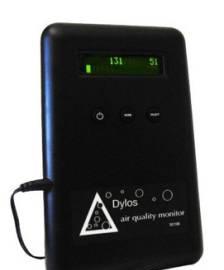
Dylos 是Smart Air自从2013年起就开始使用至今的经过验证的空气测量仪。
Laser Egg
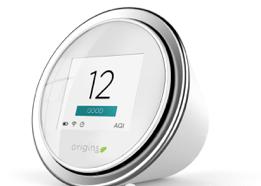
Laser Egg是目前流行的,看上去更现代化的仪器。
Node
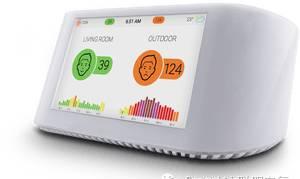
Node是更精致的版本,它有一个大屏幕,包含更丰富的信息,空气污染预报和二氧化碳水平监测。
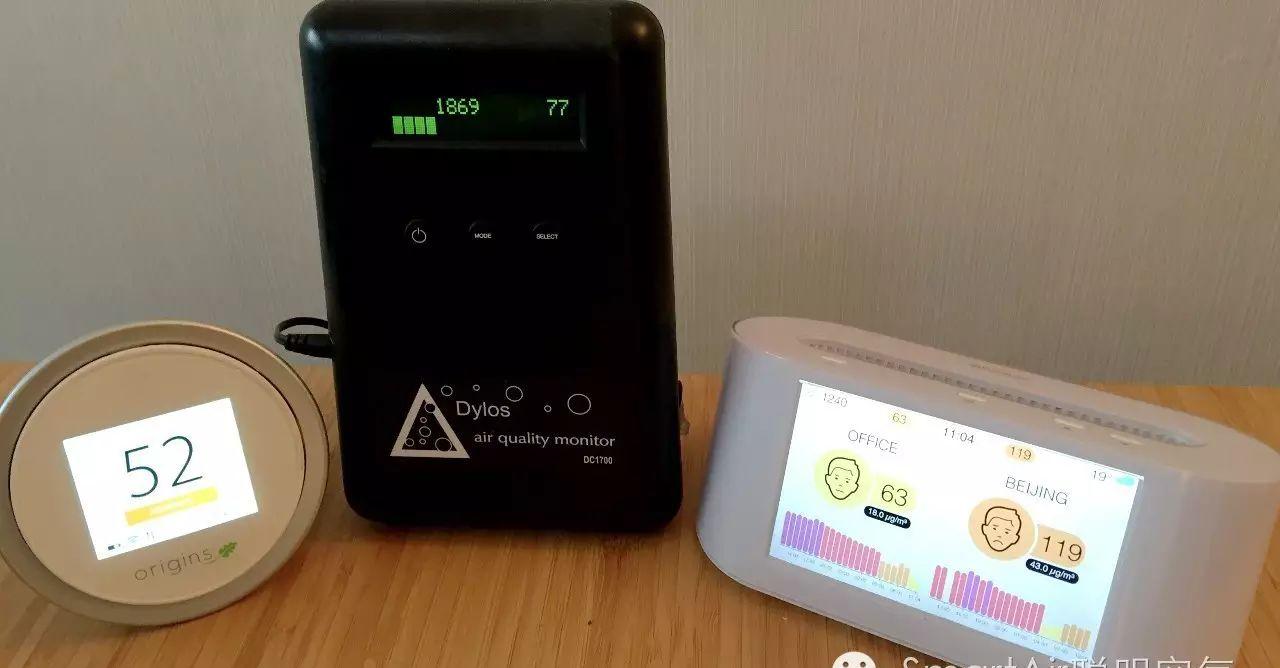
官方数据对比
我们把三种测试仪放在Smart Air办公室外进行测试。办公室在东直门外大街,距离农业展览馆的官方PM2.5检测仪1.3公里。
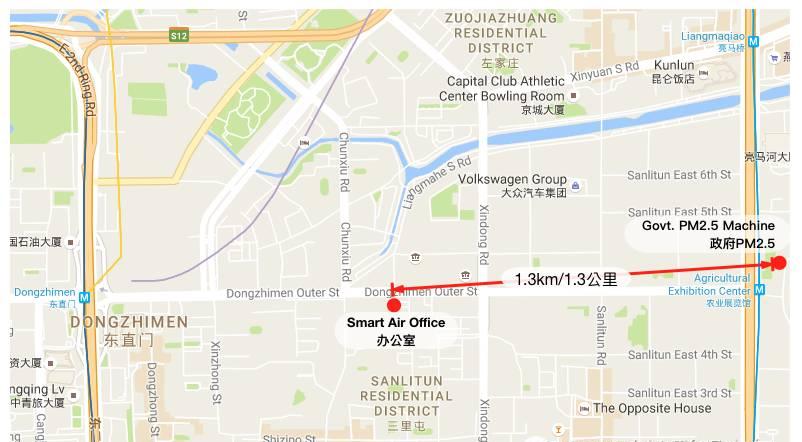
我们对这些测试仪进行了为期6天的测试。Laser Egg和Node给出的是PM2.5 微克数值,而Dylos给出的是0.5微米及以上颗粒的数量,所以我们用半官方换算公式,将Dylos读数也换算成PM 2.5微克数值。
(≥0.5微米颗粒数量-≥2.5微米颗粒数量)/100
结果
以下是我们在北京办公室外进行的三天测试的结果:
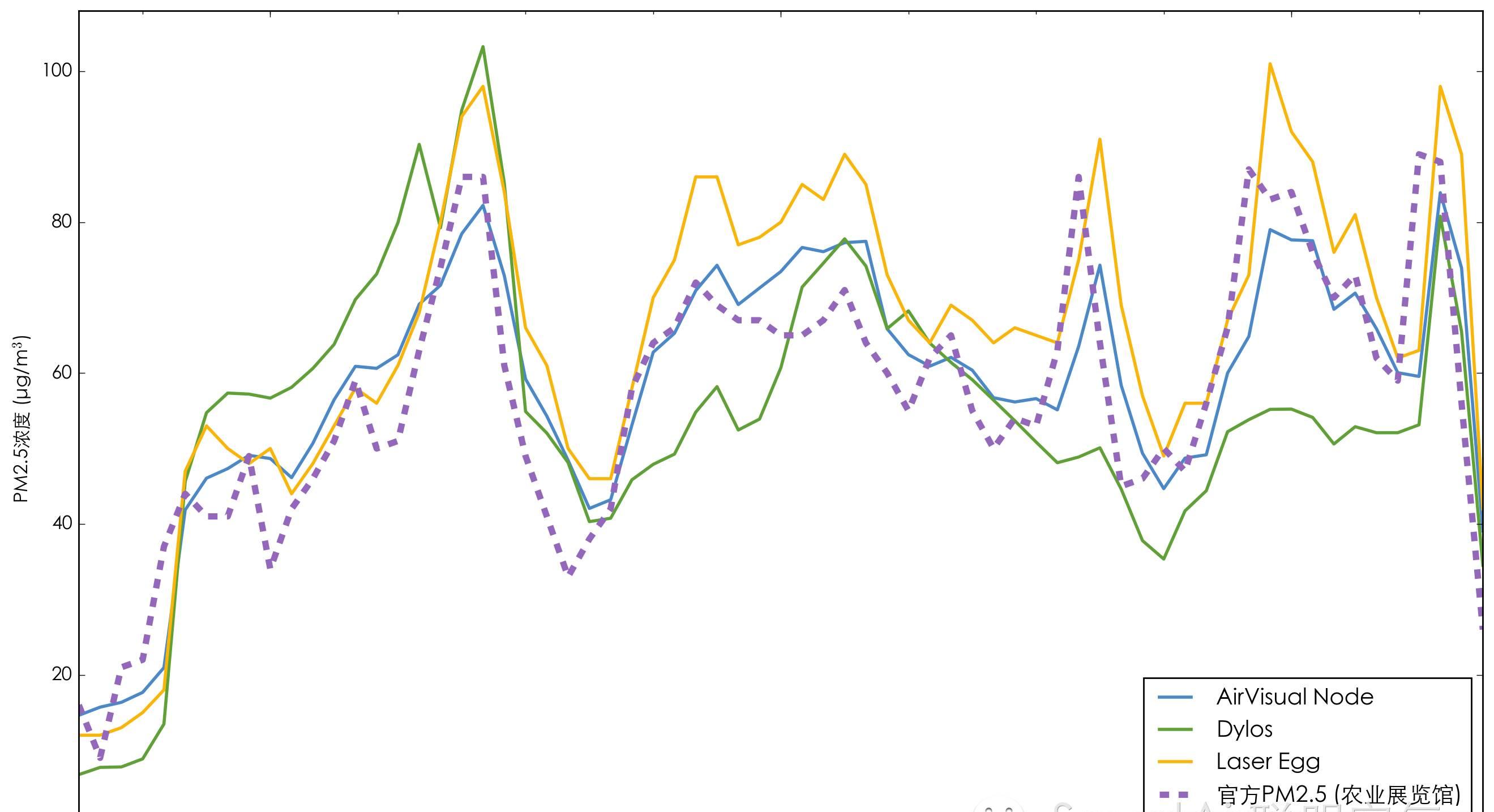
接下3天的天空非常清澈晴朗。如果你在室内用测试仪,这些数据更加有用,因为一般室内的PM2.5浓度要低于室外水平。
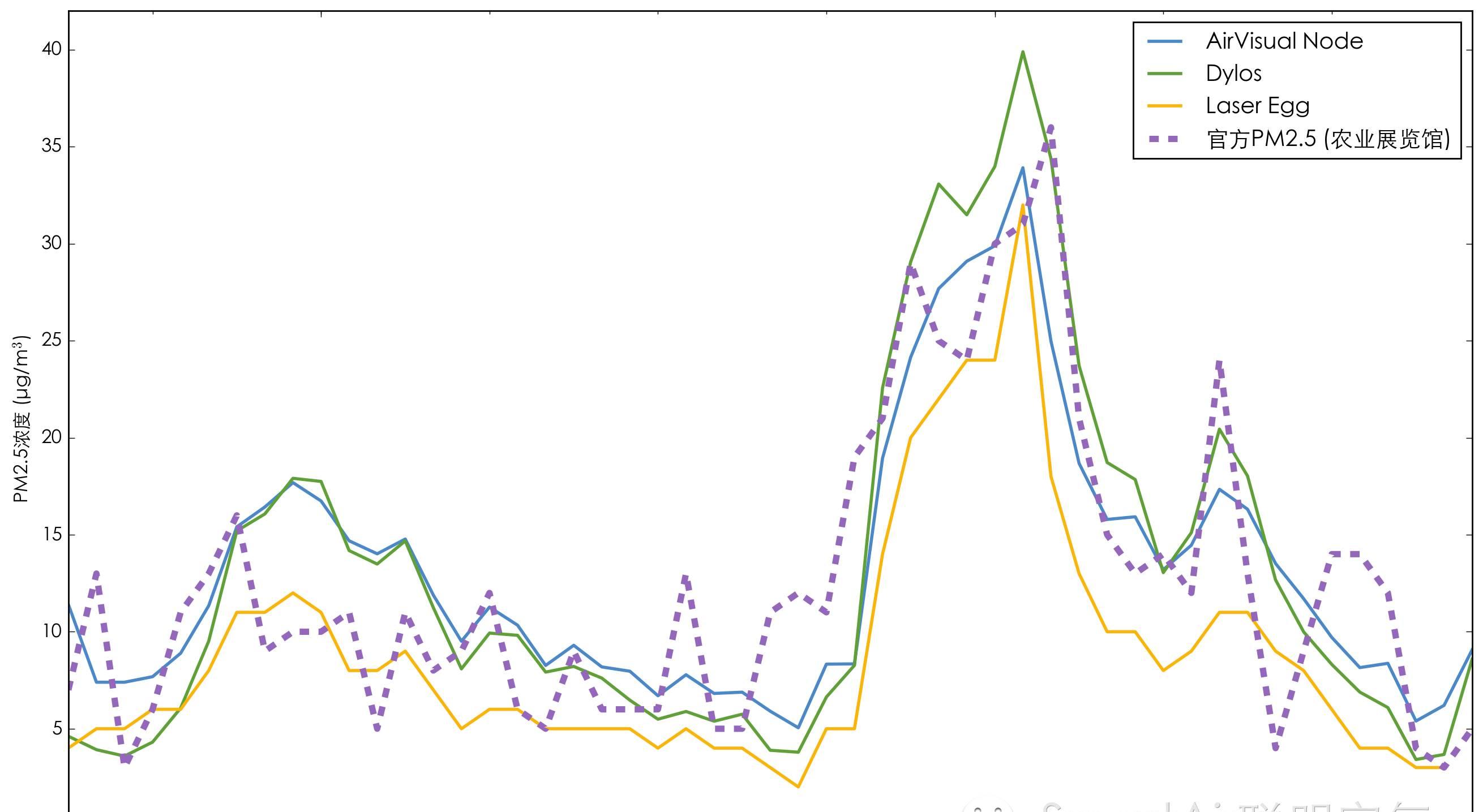
粗略来看上面两张图表,三个测试仪的数据跟官方数据的走势都很吻合。
综合两个测试,三个测试仪跟官方PM2.5数据的相关性是:
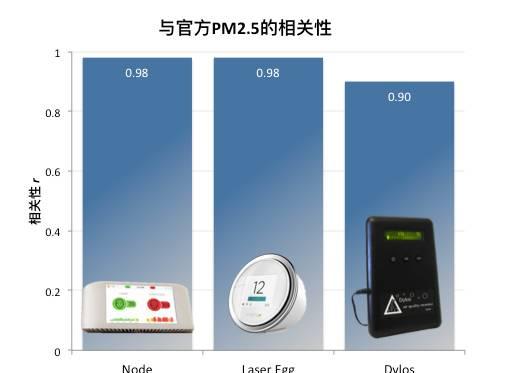
对于不是书呆子的人来说,0.98的相关性算是基本接近完全相同了!Dylos的相关性最低,但也算是很高了(这跟我们之前的测试结果很相似)。
总的来说,三种测试仪测试数据与政府官方数据的相关性都非常高。这说明它们都能很好地反映政府的官方数据。
平均偏差
另一种测量精确度的方法是看这些数据跟官方数据平均差多少微克。
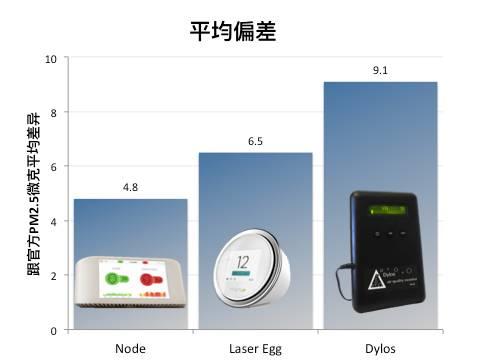
结果Node与官方数据最接近;Dylos差异最大,但是都平均差异低于10微克。
也许有一点需要注意的是,Laser Egg在空气污染程度较轻的时候,PM2.5数值始终偏低。这表示存在这种可能性:Laser Egg会低估真实的室内空气质量,给出一个让人觉得空气足够安全的假象。但是尽管如此这些偏差也不能算大。
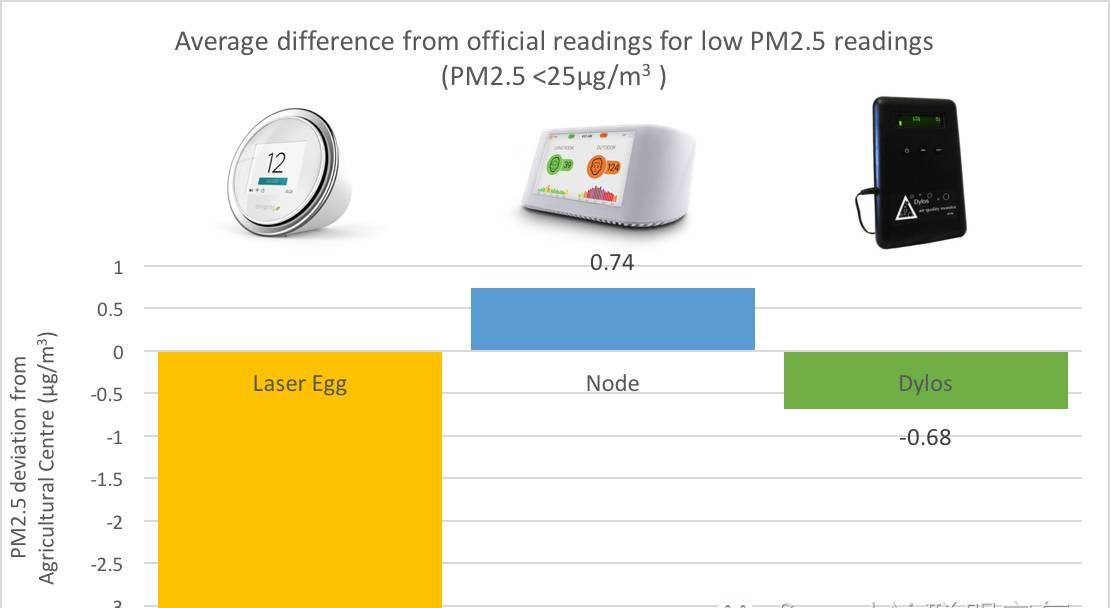
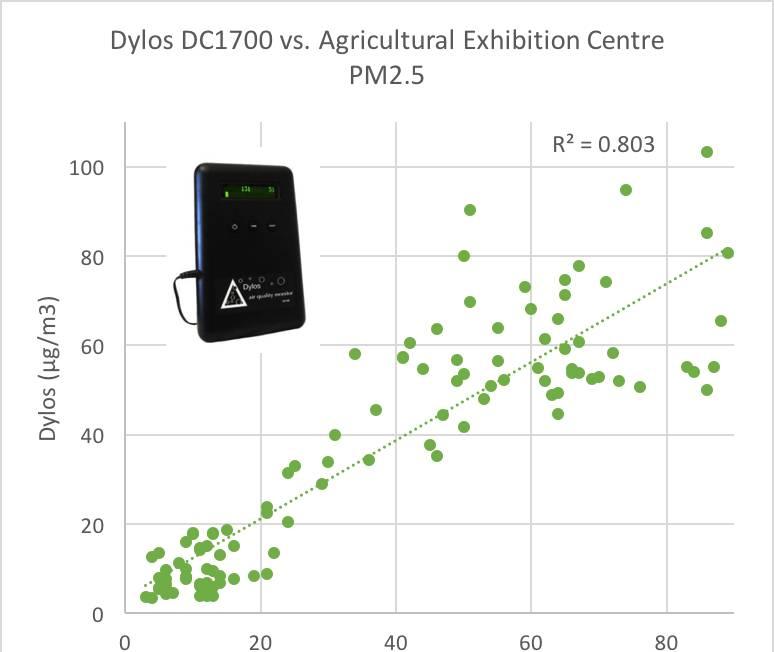
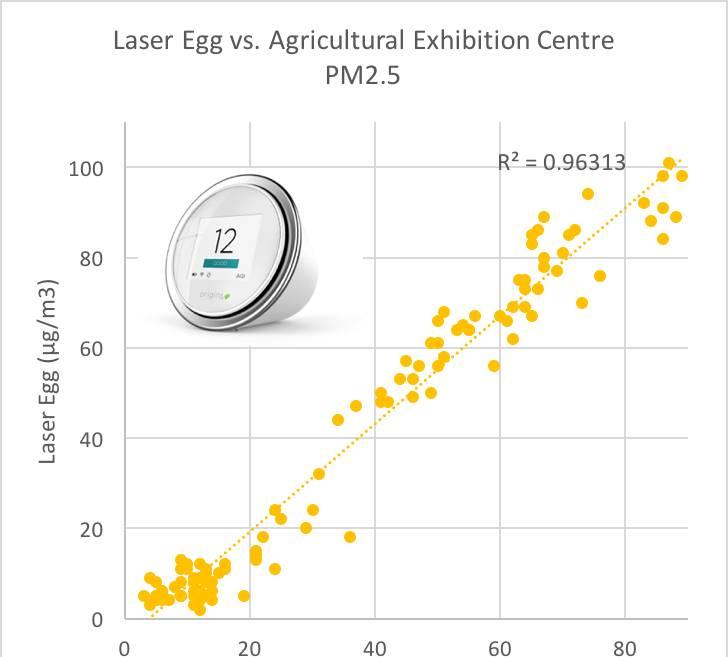
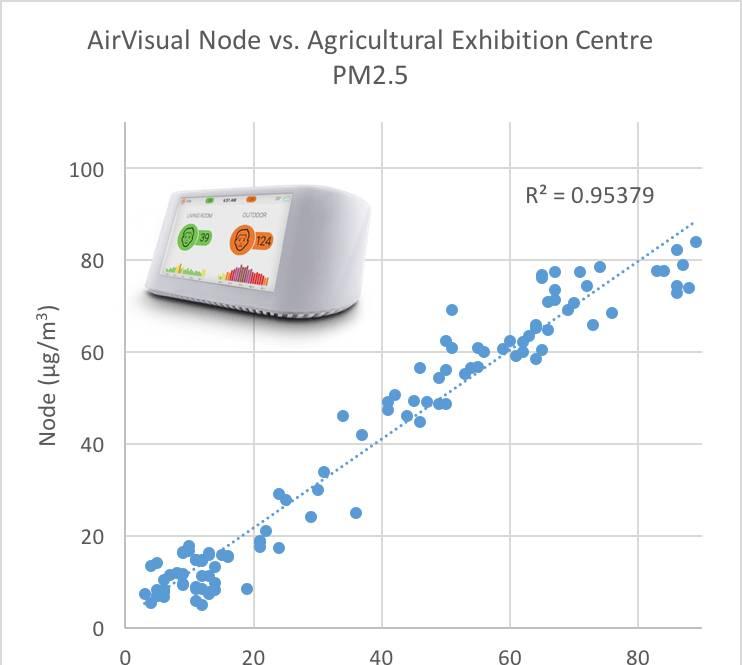
“空气末日”测试
为了检验测试仪在超高浓度污染环境中的精确性,我们在15平方米的密闭房间内点燃了一支香烟。在一位长期吸烟爱好者和一个与我们有合作关系的北京NGO的帮助下,我们成功地让这个密闭房间中的PM 2.5浓度达到了1,000微克/立方米!
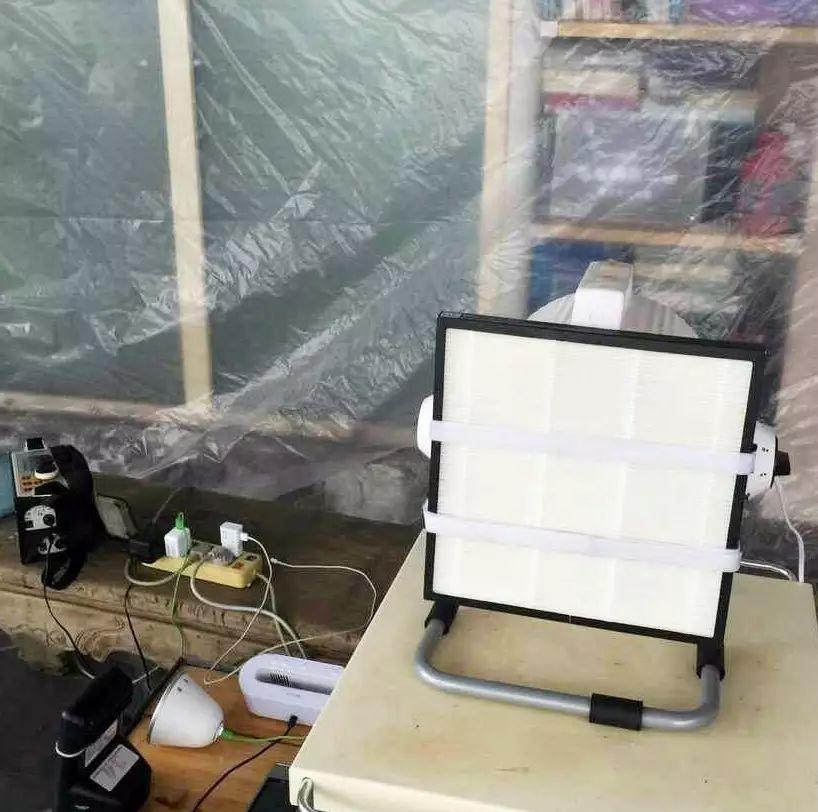
为了完成这个测试,我们还同时用了一台很高科技的Sibata LD-6S测试仪。Sibata是一台工业PM2.5测试仪,所以能够测到这种毒害的污染水平。
“空气末日”测试结果
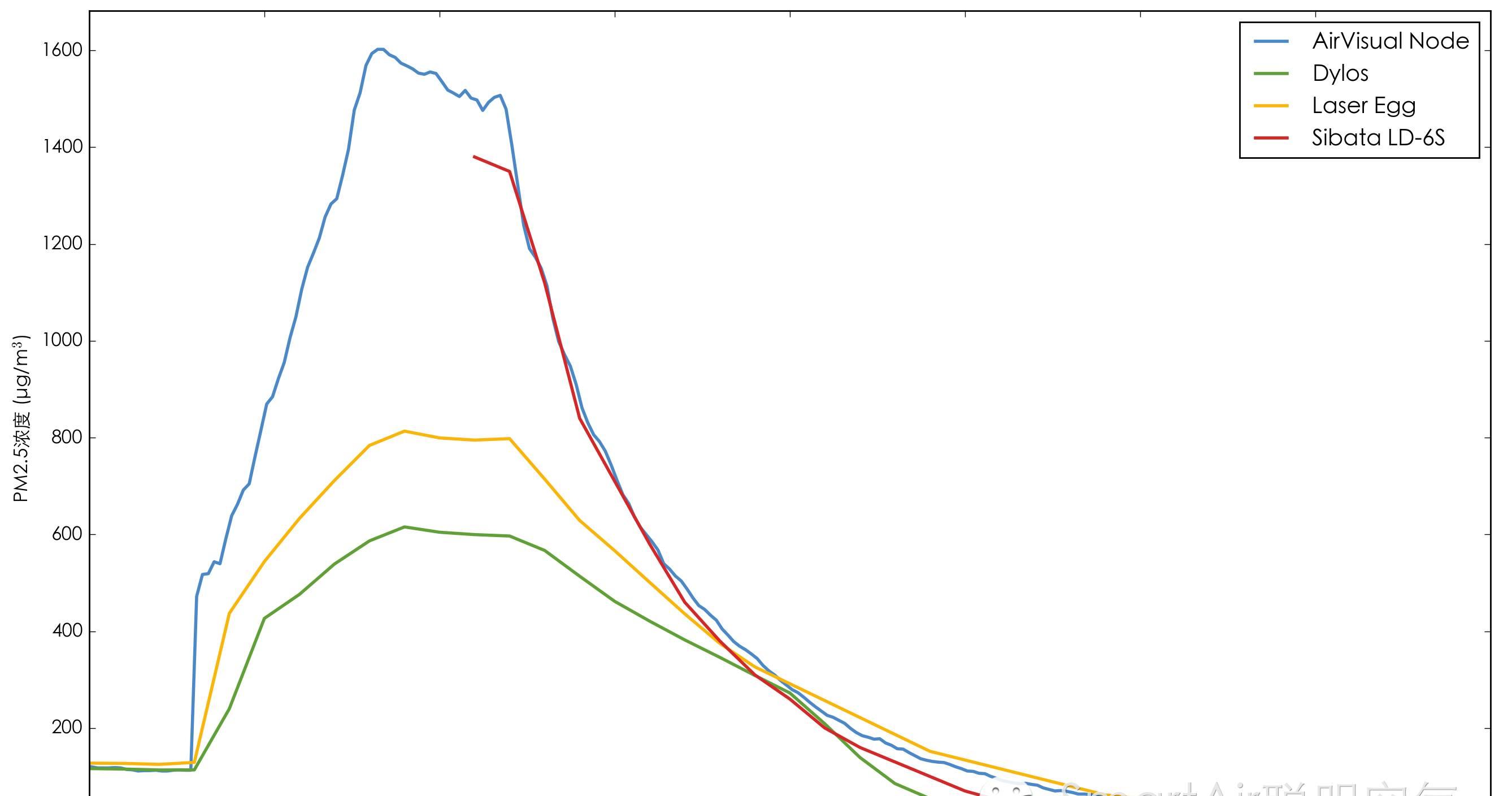
Laser Egg和Dylos在污染浓度超高的情况下读数有些“跟不上”了。相比之下,Node 和Sibata都能测量出超过1,000微克/立方米的浓度值。当然,在实验之外的环境中我们基本不会遇到需要检测这样高浓度污染的情况。
关键信息
总体来说,跟政府的测试仪相比,这三种测试仪给出的读数都相当精确。Smart Air团队认为,它们都能够较为准确地反映出家中的AQI指数。三者之中,Node得分最高,因为它在室外测试环境下与政府测试仪之间的偏差最小,并且在我们的“超级严重污染”测试中也表现出了最高的精确性。
易用性对比
既然三个测试仪的精确性都很高,现在的问题主要集中在:它们是不是方便使用?它们各自有着什么样的特点?
Dylos1800元

Dylos在这个比较中真的不怎么给力。它没有手机连接线,而且下载数据也是个痛苦的事儿——这还是在你已经有一根“老学院派式的”针型数据线的前提下。
Laser Egg 499元

Laser Egg是一款入门级的粒子测试仪。它有简单的界面并且能给出非常精确的读数。它没有那么多功能,但是在它的专攻领域中表现很好。
Node 998元

就视觉上来看,Node功能最丰富。对初级入门者来说,它能测量二氧化碳浓度,温度,还有湿度。这些功能让它更像是一个综合的“环境监测器”,而不仅仅是个空气测试仪。
CO2值怎么用?如果你所处的空间不大又同时有好多人在里面,那么二氧化碳浓度能够显示你所在的空间是否太小了。如果你的房间内因为新装修过或者有新家具而存在室内空气污染源(VOC),高浓度的二氧化碳能够表明这些室内污染物正在累积。
Node还有一些比较方便的功能:能显示过去24个小时中室内和室外空气AQI和二氧化碳指数,也能预测未来几天的情况,还有关于何时打开窗户或者何时戴口罩的建议。通过对Node一段时间的使用,我们发现这些功能在我们的办公室内还是很有用的。
通过了测试以后,我们将会在Smart Air的淘宝店和我们网站开始发售AirVisual Node。无论是在家中使用还是用作实验目的(如果你像我们一样也是个书呆子),我们愿意为需要一个靠谱测试仪的人多提供一个选择。去看看吧!
接下来的几个月里,我们希望能对更多空气测试仪(粒子计数器)进行测试,并且进行一些花费更高的测试。这只是一个开始!如果通过我们的独立测试确认了更多靠谱的测试仪,我们有可能也会把它们放到我们的淘宝货架上来。
Breathe safe!
Thomas Talhelm
Smart Air创始人
芝加哥大学助理教授
info@smartairfilters.com
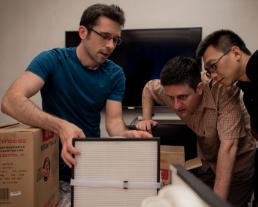
Smart Air 淘宝:smartair.taobao.com
Smart Air主页:smartairfilters.com
Are Cheap Particle Counters Accurate?
When I started Smart Air in 2013, I wanted to buy a particle counter, and I had basically two options. I could buy a US$260 Dylos or spend thousands of dollars on the crazy expensive particle counters.
Since then, the market has exploded with new particle counters as cheap as 99 RMB. But are they any good?
Putting Particle Counters to the Test
To get to the bottom of it, Smart Air tested three popular particle counters on the market: the Dylos DC1700, the Origins Laser Egg, and a new particle counter called the AirVisual Node.
Dylos

The Dylos is the trusty particle counter Smart Air has been using since 2013, since itpassed our previous test.
Laser Egg

The Laser Egg is the popular, more technologically savvy device.
Node

And the Node is a fancier version, including a large screen, richer information, pollution forecasts, better user experience, and even a CO2 monitor.

The Government Comparison Test
We put the machines outside the Smart Air office on Dongzhimen Waidajie for six days. We compared their numbers to the official PM2.5 numbers from the government PM2.5 monitor at the Agricultural Exhibition Center about 1.3km away.

The Laser Egg and the Node give output in PM2.5 micrograms. The Dylos gives number of 0.5 micron particles, so we converted it to PM2.5 micrograms using the semi-official formula:
(0.5 microns – 2.5 microns)/100
Results
The first three days had pretty normal levels of summer pollution. All three machines tracked the official numbers pretty well.
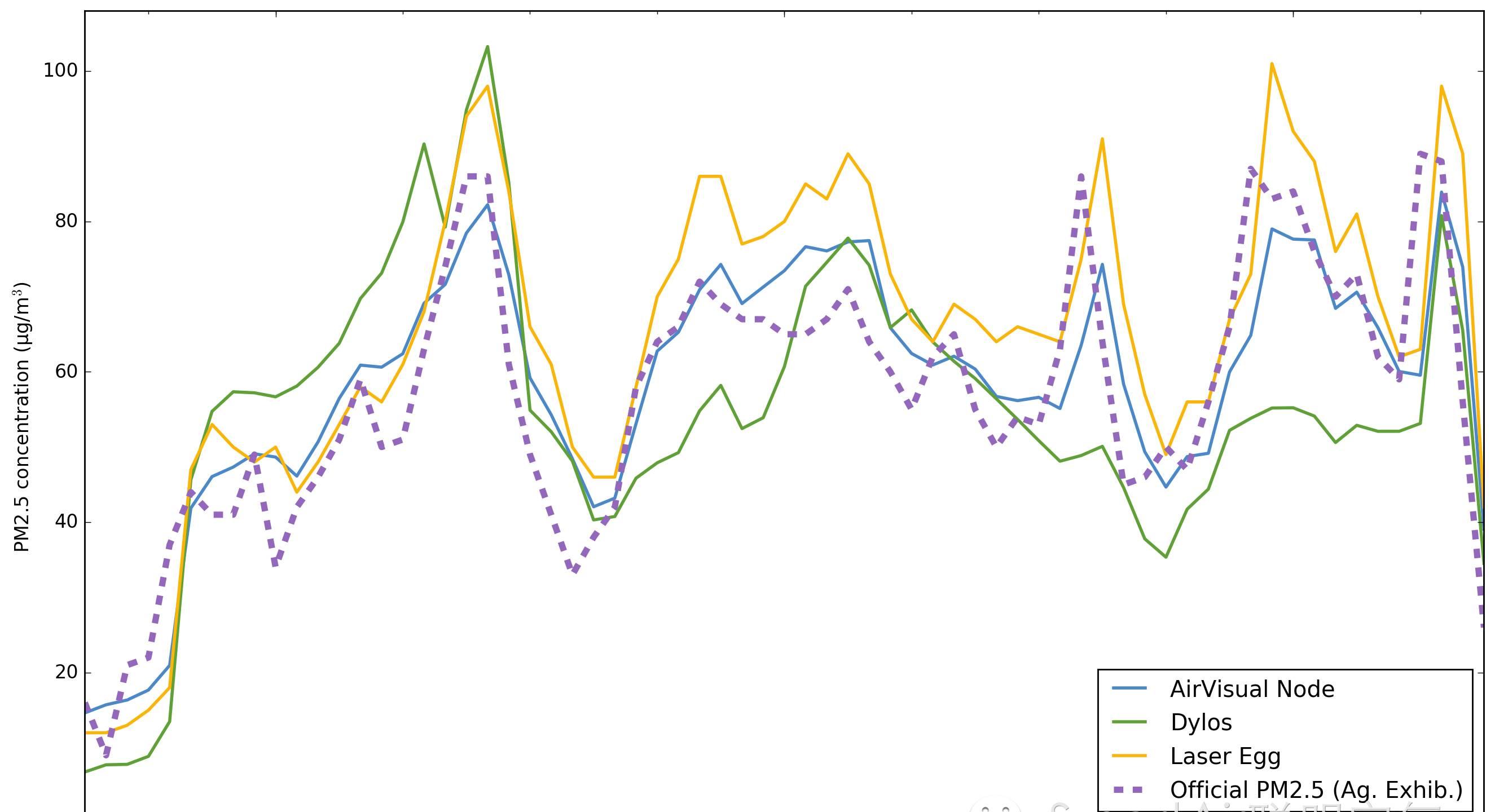
The next three days had extraordinarily low PM2.5. That’s helpful because concentrations in homes — where most people use particle counters — are below outdoor levels.So this data is good for testing how good the devices are at low concentration levels.
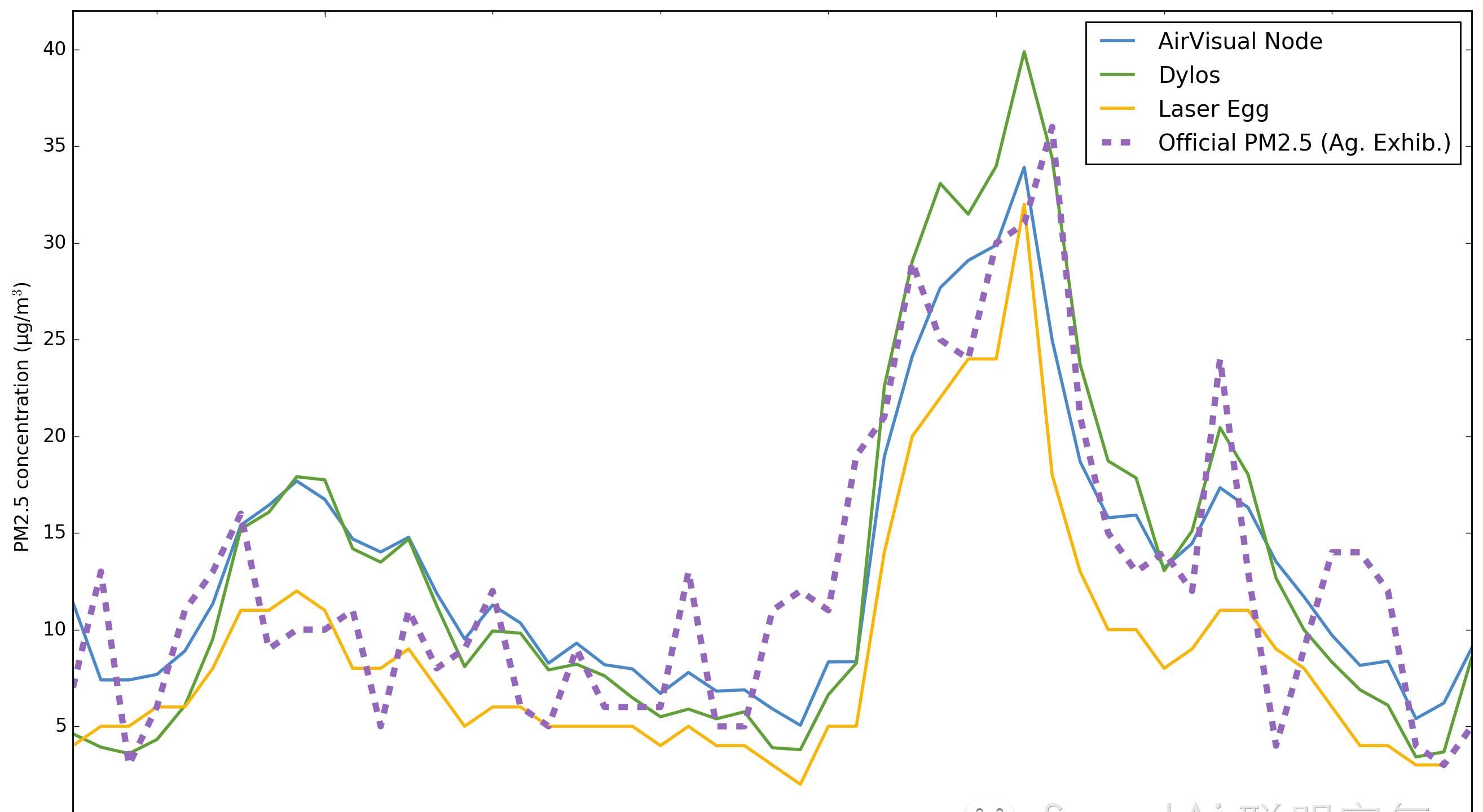
Again, all three machines did a pretty good job of tracking the official numbers.
Who Scored The Best?
We combined all the days and calculated the correlation of each machine with the official PM2.5 numbers.
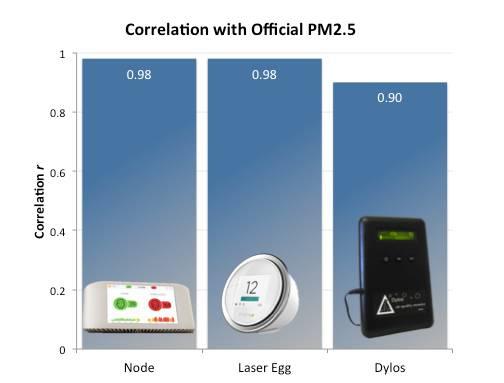
All the machines correlated very highly. For non-nerds, 0.98 is incredibly close to identical! The Dylos had the lowest correlation atr= 0.90, but still incredibly high (and similar to our previous test).
Average Deviation
Another way to measure accuracy is to look at how far the numbers were from the government data on average.
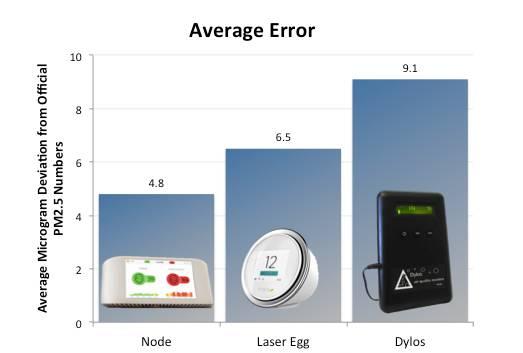
The Node had the lowest error, and the Dylos had the highest error. But all three were off by less than 10 microns on average.
Perhaps one worry to note is that the Laser Egg was consistently under-estimating PM2.5 while air pollution was in the lower range. This means there could be a risk that the Laser Egg underestimates the real pollution levels in the home, giving a false sense of security.

The graph above shows for official readings under 25??g/m3, the Laser Egg was on average reading 3.4??g/m3 under the official data. That means the Laser Egg was underestimating the PM2.5 concentration by an average of 14%. The other two devices read much closer to the official readings ( 3% for the Node and -3% for the Dylos).



The Airpocalypse Test
To test accuracy at extremely high concentrations, we burned a cigarette in a closed 15m3 room. Our goal here was to see how well the particle counters were at reading concentration levels over a whole range of values, including toxic levels. With the help of cigarettes and a partner NGO in Beijing, we managed to get the concentration above 1,000??g/m3!

For this test we also used an industrial Sibata LD-6S. This machine is designed to handle extremely high concentrations, so we used it as the baseline.
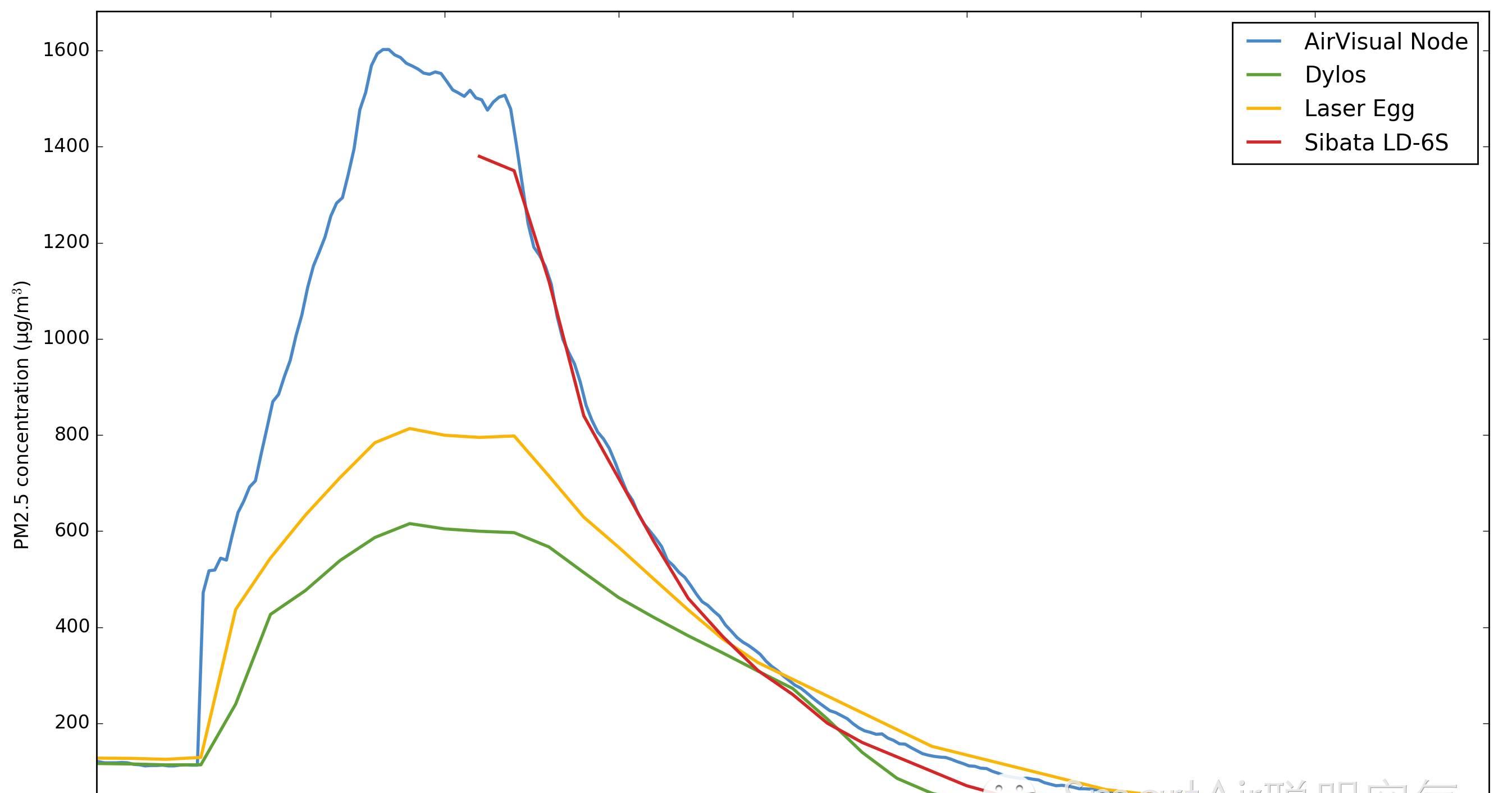
The Laser Egg and the Dylos had a hard time keeping up with these toxic levels of concentration. In contrast, the Node and the LD-6S were able to measure values over 1,000??g/m3. The Node won this test, although the chance you’ll need to measure values this high is slim.
Take-Home Message
Overall, the three particle counters were reasonably accurate compared to the government machines. In the estimation of the Smart Air team, all of them are suitable for giving an approximate AQI value. Of all three, the Node scored the highest, with the lowest deviation from the government machines in both outdoor tests and the highest accuracy in the “crazy bad” test.
Usability
Since all three machines are reasonably accurate, the question then really comes down to: How easy it is to use the device? And what features do they have?
The Dylos (1800 RMB)

The Dylos easily loses this fight. It has no phone connectivity, and downloading the data is a terrible pain—and that’s if you have one of the old school pin connecter cables.
The Laser Egg (499 RMB)

The Laser Egg is a solid entry-point particle counter. It gives reasonably accurate results with a simple interface. It’s not feature rich, but it does what it says on the box.
The Node (998 RMB)

To our eyes, the Node offers the best features. For starters, it can measure CO2, temperature, and humidity. That makes it more of an “environment monitor” than just a particle monitor.
What can we do with CO2 levels? CO2 is important because CO2 can build up to dangerous levels if you have lots of people in a small space. Air quality experts also use CO2 as a hint of indoor air pollution. If you have sources of air pollution (VOCs) like new furniture or remodelling, high CO2 levels will suggest that VOCs are building up too.
The Node also has other helpful data. It shows AQI and CO2 for the past 24 hours both indoors and outdoors, a forecast for the coming days, and suggestions to help you decide when to open your windows and wear a mask. We’ve found these features helpful in our office.
After completing our tests, Smart Air has decided to start shipping the AirVisual Node through our Taobao shop and website as an option for anybody wanting a solid device for both home use and research (if you’re a nerd like us).
And over the next few months, we hope to get a larger pool of particle counters together and run some more extensive tests. This is only the beginning! Once we’ve independently verified more devices, we may well be adding them to our shop as well.
Breathe safe!
–Thomas Talhelm
Founder Smart Air
Assistant Professor University of Chicago
info@smartairfilters.com

Smart Air Taobao: smartair.taobao.com
Smart Air Website: smartairfilters.com










